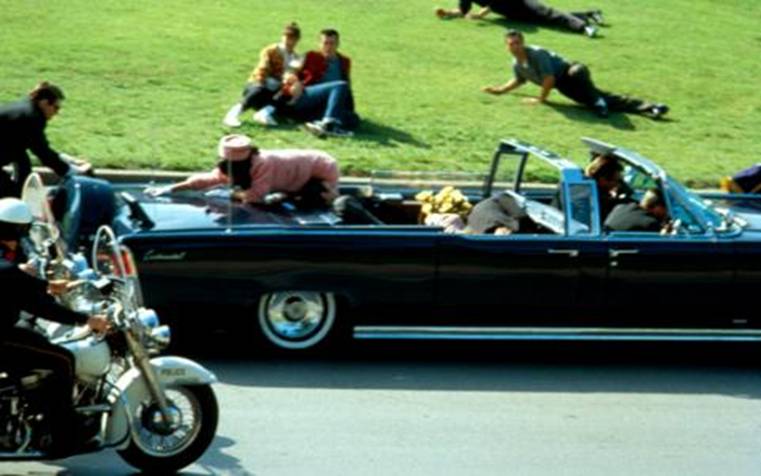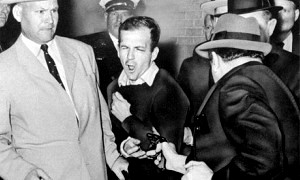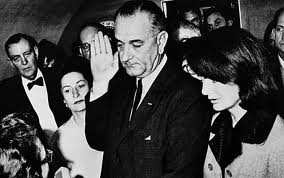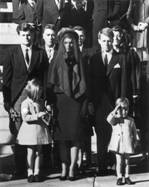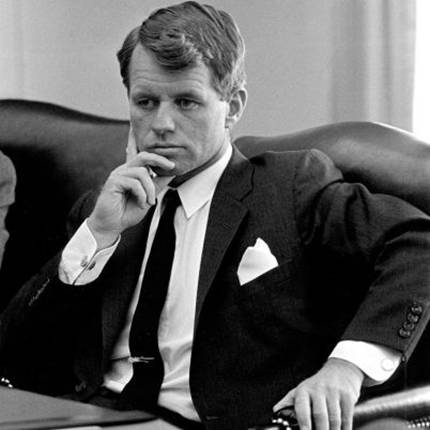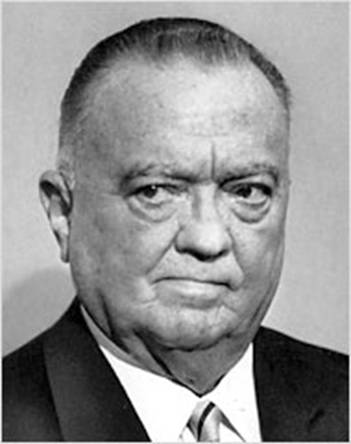|
50 Years from that Fateful Day in By Martin J.
Steadman |
||||
|
Zapruder Film |
||||
|
Fifty Years from that Fateful
Day in By
Martin J. Steadman The
murder of President John F. Kennedy in As
early as November 25, on the day the President was buried, Federal Bureau of
Investigation Director J. Edgar Hoover and newly-sworn President Lyndon
Johnson reached agreement to squelch widespread speculation that Lee Harvey
Oswald had acted in concert with conspirators unknown. And
of all the mysteries about the assassination that linger 50 years later, none
is more baffling than the decision by Attorney General Robert Kennedy to
distance himself and his Justice Department from the feeble inquiry that
followed. The Johnson/Hoover deal to stifle
speculation about the assassination of President Kennedy resulted in the
appointment of a Presidential Commission to inquire into everything that
happened on that weekend in That’s right. The new President and the FBI Director made
up their minds immediately that Oswald killed Kennedy, and Ruby killed
Oswald, and case closed. The
White House moved swiftly. Within days
President Johnson lined up the members of his Blue Ribbon panel, and on
November 29 he signed an Executive Order creating the President’s Commission
on the Assassination of President Kennedy.
Within seven days of the death of John Kennedy and five days of the
murder of Lee Oswald, the White House had assembled an impressive group of
national leaders headlined by the Chief Justice of the Supreme Court, Earl
Warren. The panel was charged with
“finding the full facts of the case and reporting them, along with
appropriate recommendations, to the American people.” Shortly
after the announcement of the appointment of the Warren Commission the
Associated Press sent a story on its national wire, reporting that a
high-ranking official of the Justice Department said the murder of President
Kennedy was the work of a lone assassin, and no evidence of a conspiracy had
been found linking Oswald to Jack Ruby or anyone else. The Associated Press at that time had my
respect and admiration. But that was
the moment my illusions were forever shattered. The AP was used and abused by the President
and the Director of the FBI. I
was in Already the newspaper stories out of The Herald Tribune editors sent Haddad to No one at the Herald Tribune that day could
have known that while the paper was assigning its two investigative reporters
to Washington and Dallas, the White House and the FBI had already closed the
case. One more time--they closed the
case on the day the President was buried..
We knew nothing about a top-level, secret pact to close the case
prematurely, and that surely was true in newsrooms all over I spent 11 days in Dallas following the
murder of President Kennedy, from November 26 to December 6, and I never
wrote a word about my time there, mostly because I came home with no proof of
anything conclusive about the unanswered questions-- many of which are still
unanswered I came home only with a
deep, unsettling feeling that I was leaving Dallas too soon. But as the years go by, I believe I have
an obligation to write some things that I feel strongly about, especially as
November 22 approaches each year.
Every year since 1963, I’ve
been left with (a) major grievances against the highest-ranking people in our
own government and (b) a haunting memory of a private interview with a doctor
who attended the dying President, and (c) some bits and pieces of information
that might help historians to a
consensus on what was most likely the case.
The official finding that Oswald acted alone is believed by almost no
one today.
AT LAST A THOROUGH, HONEST INVESTIGATION The Warren Commission, guided by §
“The
Federal Bureau of Investigation failed to investigate adequately the possibility
of a conspiracy to assassinate the President.” §
“With
an acute awareness of the significance of its finding, the committee
concluded that the FBI’s investigation of whether there had been a conspiracy
in President Kennedy’s assassination was seriously flawed.” §
“The
former Assistant Director, since deceased, who coordinated the FBI’s
investigation characterized the effort in testimony before the Senate Select
Committee with Respect to Intelligence Activities as rushed, chaotic and
shallow, despite the enormity of paperwork that was generated.” §
“The
committee concluded that the FBI’s investigation into a conspiracy was
deficient in the areas most worthy of suspicion--organized crime, pro- and
anti-Castro Cubans, and the possible association of individuals from these
areas with Lee Harvey Oswald and Jack Ruby.
In those areas in particular, the committee found that the FBI’s
investigation was in all likelihood insufficient to have uncovered a
conspiracy.” §
“The
committee established that the FBI’s own Organized Crime and Mafia
specialists were not consulted or asked to participate to any significant
degree. The Assistant Director who was
in charge of the Organized Crime division--the Special Investigations Division--told
the House committee, ‘They sure didn’t come to me…We had no part in that that
I can recall.’” §
“The
committee further concluded that the critical early period of the FBI’s
investigation was conducted in an atmosphere of considerable haste and
pressure from Final reports from Congressional committees
don’t get any tougher than that.
Especially as they relate to the Federal Bureau of Investigation. Beginning in late 1977, the House committee
pieced together Jack Ruby’s connections to organized crime, something the FBI
had brushed off and the Warren Commission simply ignored. Incidentally, Chief Justice Earl Warren
made a critical error at the outset of his assignment. He decided the Warren Commission did not
need investigators. He assembled a
staff of 14 lawyers and relied almost exclusively on the FBI for the
investigative work. He and his
Commission did this with full knowledge the FBI had already given them a
hastily prepared report—written before they even began-- that found no
evidence of a conspiracy. The investigation by the
House Select Committee on Assassinations (HSCA) was directed by G. Robert
Blakey, whose first job in As
chief counsel to the McClellan Committee, Kennedy relentlessly pursued both
Jimmy Hoffa and Paul Dorfman, and the sweetheart deal they had reached. Dorfman gave Hoffa the Mob Muscle he needed
to consolidate his growing power in the Teamster hierarchy, and in return
Dorfman’s stepson Allen was given control of investments by the massive
pension funds of the Central States Conference of Teamsters. The Dorfmans, father and stepson, made
millions on the arrangement, and to this day no one knows how much of that
money was shared with their partners in crime. Paul Dorfman, remember, ran the Teamster
leader James R. Hoffa despised Bob Kennedy, which was well known at the
time. Hoffa also hated John F.
Kennedy, who sat in on the McClellan Committee hearings as a Senator from “In the most remarkable of all my exchanges
with Jimmy Hoffa,” Kennedy wrote, “not a word was said. I called it ‘the look.’ It was to occur fairly often, but the first
time I observed it was on the last day of the 1957 hearings. During the afternoon I noticed that he was
glaring at me across the counsel table with a deep, strange, penetrating
expression of intense hatred. I
suppose it must have dawned on him about that time that he was going to be a
subject of a continuing probe—that we were not playing games. It was the look of a man obsessed by his
enmity, and it came particularly from his eyes. There were times when his face seemed
completely transfixed with this stare of absolute evilness. It might last for five minutes—as if he
thought that by staring long enough and hard enough he could destroy me. Sometimes he seemed to be concentrating so
hard that I had to smile, and occasionally I would speak of it to an
assistant counsel sitting behind me.
It must have been obvious to him that we were discussing it, but his
expression would not change by a flicker. “During the 1958 hearings, from time to
time, he directed the same shriveling look at my brother. And now and then, after a protracted,
particularly evil glower, he did a most peculiar thing: he would wink at me. I can’t explain it. Maybe a psychiatrist would recognize the
symptoms.” Now
in 1963, several years after he experienced and then wrote those words, Bob
Kennedy was burying his brother, but across On the plane from Consider
the blizzard of long-distance telephone calls unleashed by Ruby in the three
weeks prior to the assassination.
Blakey and his House Committee found a Suspicious?
How about stunningly suspicious?
Many of Ruby’s frenetic phone calls were to associates of Organized
Crime chieftains Santo Trafficante and Carlos Marcello, and ultimately to a
very close associate of Jimmy Hoffa--two such calls in November were to
Robert “Barney” Baker, Hoffa’s notorious strong-arm man for many years. At one point in testimony before the HSCA,
Baker said there was “nobody closer to Jimmy Hoffa” than himself. Baker was a 320-pound gorilla whose dearest
friends were ruthless killers. He
appeared before the McClellan Committee in 1958 and an exchange with Chief
Counsel Robert Kennedy says all you need to know about Barney Baker. He was asked about the killing of Anthony
Hintz, a famous District Attorney Hogan was later on
top of a gangland attempt by Hoffa to gain control of the Mr. Kennedy: Do you know Cockeye Dunn? Mr. Baker: I don’t know him as Cockeye
Dunn. I knew him as John Dunn. Mr. Kennedy: Where is he now? Mr. Baker: He has met his maker. Mr. Kennedy: How did he do that? Mr. Baker: I believe through electrocution in
the City of Mr. Kennedy: Did you know “Squint” Mr. Baker: Mr. Sheridan, sir? He also has met his maker. Mr. Kennedy: How did he die? Mr. Baker: With Mr. John Dunn. Mr. Kennedy: He was electrocuted? Mr. Baker: Yes, sir. Mr. Kennedy: He was also a friend of yours? Mr. Baker: Yes, he was a friend of mine. Chief Counsel Kennedy then asked Baker
about a third man involved in the killing of Anthony Hintz, a gangster named
Danny Gentile. Mr. Kennedy: Where is he now? Mr. Baker: I don’t know where he could be
now—excuse me. I believe he was
implicated in a certain case in Mr. Kennedy: That was the Hintz killing. You see we have testimony that you were
closely associated with these people, Mr. Baker. Mr. Baker: Yes, I knew them real well. For good measure, Baker testified he knew a
number of other underworld luminaries, such as Joe Adonis, Meyer Lansky,
Bugsy Siegel, Trigger Mike Coppola and Vincent Alo, (also known as Jimmy Blue
Eyes) who was identified as a close friend of Cockeye Dunn at the trial. Ten years or so after the Hintz murder,
when I was a young reporter at the Journal-American, a veteran NYPD detective
told me Vincent Alo was the new Boss of Bosses in Hoffa
took the witness stand immediately following Baker’s appearance, and after
saying Barney Baker “works under my direct orders,” Hoffa was asked if Baker’s
testimony that he associated with killers, gangsters, gamblers, racketeers,
traffickers in narcotics and human flesh bothered him at all. The response
was typical Jimmy Hoffa. “I am sure, hearing him testify here
that he knew every one of them…it doesn’t disturb me one iota.” I’m
focusing on Jack Ruby’s phone calls to Barney Baker shortly before the
assassination of President Kennedy (two of dozens of such calls Ruby made to
known racketeer enemies of the Kennedy brothers) because those lengthy
conversations between Baker and Ruby two weeks before the President was
murdered should have set off loud alarms in law enforcement circles
immediately. For
emphasis--Immediately. Repeat--Right
Now, Stupid. Barney
Baker called Jack Ruby from Baker was under oath, but he had a comfort
level against a possible perjury charge--when he was interviewed by the HSCA
in 1978 Ruby had been dead for 1l years.
But that brings us to how the Warren Commission handled the same
telephone log information 14 years earlier, when Ruby was in custody and
still alive. Baker wasn’t interviewed
by the FBI until Another of the suspicious phone calls was to
Irwin Weiner, a notorious money man for the Teamsters and the Mob. Weiner wrote bonds for huge loans from the
Central States Conference of Teamsters (Hoffa) to mob-connections in So
when he testified at the HSCA many years after the phone call, Weiner adopted
the same line Barney Baker used--he testified Ruby called to ask him to write
a bond that Ruby needed to bring an injunction against the American Guild of
Variety Artists, and Weiner told him he didn’t want to get involved in a
Texas matter, far from his Chicago office.
That alibi was so unbelievable that Members of the Congress on the
committee took turns telling Weiner they didn’t believe him. Were there no insurance agencies in |
||||
|
Robert F. Kennedy |
J. Edgar Hoover |
|||
|
ATTORNEY GENERAL ROBERT KENNEDY EXCLUDED When
President Johnson and FBI Director Hoover agreed on the appointment of the
Warren Commission and immediately provided the fledgling committee with an
FBI report that said there was no conspiracy to kill President Kennedy,
Attorney General Robert F. Kennedy and the Justice Department were cut out of
the loop. The FBI works for the
Attorney General, but in this case President Johnson decreed that It wasn’t just Barney Baker and Irwin
Weiner. Many of Ruby’s toll calls were
placed to associates of two major Organized Crime chieftains that controlled
the South and Southwest--Santo Trafficante of By
1964 that initial list of 40 had grown to 2,300 Organized Crime figures and
175,000 profiles in the Justice Department’s master file on Carlos Marcello had another, more personal
reason to want either or both of the Kennedy brothers dead. On Eventually the two wanderers made contact
with Guatemalan officials again and this time things went a little more
smoothly. Actually, this time they got
the red carpet treatment. Marcello and
his lawyer were flown on a Guatemala Air Force plane to “Two marshals put the handcuffs on me and
they told me I was being kidnapped and being brought to Guatemala….and in
thirty minutes…I was in the plane…They dumped me off in Guatemala…They just
snatched me, and that is it, actually kidnapped me!” Writing in his book Fatal Hour,
Chief Counsel Blakey said Marcello explicitly fixed the responsibility for
his deportation: “(Kennedy) said…he
would see that I be deported just as soon as he got in office. Well he got in office January 20…and April
the 4th he deported me.” Attorney General Robert Kennedy was just
getting warmed up when his marshals flew Marcello out of the country. Six days later the Internal Revenue Service
filed an $835,000 tax lien against Mr. and Mrs. Marcello, and less than a
week after he returned to the Arthur Schlesinger Jr. was a trusted friend
of the Kennedy family, and on the night of “There could be no serious doubt that
Oswald was guilty,” Kennedy replied.
“But there was still argument if he had done it by himself or as part
of a larger plot, whether organized by Castro or gangsters.” That conversation was less than three weeks
after the assassination, and if at that moment Bob Kennedy knew Jack Ruby had
telephone contacts with Barney Baker
and Weiner and associates of Trafficante and Marcello in the weeks before his
brother was murdered, that almost certainly would have spurred the Attorney
General into action of some sort Bob
Kennedy knew Baker from personal experience and his band of brothers at the
Justice Department knew all of the gangland players identified years later by
the House Select Committee. If they
knew Jimmy Hoffa’s closest associates were in Jack Ruby’s November telephone
records, along with known associates of Trafficante and Marcello, Robert
Kennedy and his Justice Department could not have remained silent. Which raises another question that is so
difficult to comprehend. How could all
of that talent and knowledge and experience at Attorney General Robert
Kennedy’s Justice Department have been silenced for the 10 months the Warren
Commission conducted its inquiry?
Initially, Bob Kennedy removed himself from the events that followed
the assassination of his brother, on the grounds that it would not seem
proper for him to lead the investigation.
But he and his powerful Organized Crime strike force accepted the role
of unconcerned spectators totally. At
no time from the murder in SPINNING MY WHEELS IN When
the FBI quickly leaked its conclusions that Oswald acted alone and Ruby
killed Oswald to avenge the murder of the President, much of the air went out
of my Agronsky’s interview remains a classic
instruction for young journalism aspirants everywhere. Always sensitive, always conscious of the
Governor’s condition and his wife’s concerns, always aware that the Governor
and his wife were wounded witnesses to history, Agronsky’s interview nevertheless
documented the horrifying moments in the rear seats of an open limousine in
Dallas that can never be fully explained or forgotten. Agronsky and the reporters downstairs
hanging on every word by Governor Connally, had no idea that the Governor’s
recollections of what happened that day would conflict with the conclusions
of the Warren Commission a year later.
Somehow, Governor Connally’s most critical moments meant nothing at
all to the Warren Commission. His
recollections didn’t fit their findings. I had been elsewhere scrounging for any
scrap of information missed by the first wave of reporters to descend on
Dallas and when I got to Parkland Hospital just in time to learn that the
Agronsky interview would be taking place upstairs, I missed the briefing that
instructed the pool reporters that the TV interview would be embargoed for an
hour to give the reporters assembled downstairs time to file. I alerted my
newsroom and I took only a few sketchy
notes as Agronsky worked his deft touch, believing the interview was going
live around the world and I was covered by my newsroom back in The
interview over, I called my office and said, “Okay. Did you get all that?” “Get all what?” was the answer. “We don’t have anything.” Oh, no.
My first solid story down there, and all I had was sketchy notes. A I felt like a dope, but the paper put my
byline on the story and nobody gave me any more grief than I had already
taken upon myself. After that incident, I told the City Desk
there was too much happening in There were no more glitches, and when
Ferretti arrived a day later I was pretty much free to roam again. In fact, there were occasions when I wanted
Fred to accompany me. One such
memorable evening was an interview with Dr. Malcolm Perry at his home. Dr. Perry was among the team of doctors at The meeting with Dr. Perry occurred the
evening of December 2. Fred and I were
joined by Stan Redding, a first-class crime reporter for the Houston
Chronicle. I’d taken a liking to Our meeting with Dr. Perry was after
dinnertime at his home, and I remember a little girl playing with her toys on
the living room floor as the three reporters and her father talked about how
he tried to save a President’s life.
She was oblivious to the gravity of the conversation, playing quietly
with her toys throughout. Dr.
Perry had become a controversial figure in the assassination story--to his
dismay. With the President lying on
his back on a gurney, fighting for breath in his dying moments, Dr. Perry
tried to create an air passage with an incision across what he believed to be
an entrance wound at the front of Kennedy’s neck. The President was pronounced dead soon
after, but the doctor’s incision at the throat had forever foreclosed a
conclusion that the wound was an entrance wound or an exit wound. Late that Friday afternoon, the So
little more than a week later, three reporters were speaking quietly to the
surgeon at the center of the dispute.
As far as I know, it was the first and only such private interview
with Dr. Perry. None of us in his
living room that night took out a notebook or a pencil. It was a conversation with a clearly
reluctant surgeon who had done his best in a crisis and who had agonized
about it since. Dr. Perry said he believed it was an
entrance wound because the small circular hole was clean, with no edges. In the course of the conversation, he was
asked and answered that he had treated hundreds of gunshot victims in the
Emergency Rooms at But he told us that throughout that night,
he received a series of phone calls to his home from irate doctors at the When
he was finished, there was only one question left. I asked him if he still believed it was an
entrance wound. The question hung
there for a long moment. “Yes,” he said. Ultimately
Dr. Perry appeared as a witness before the Warren Commission. In substance he testified that he realized
he had no proof the bullet hole in the President’s neck was an entrance
wound, and he conceded that the I can’t fault Dr. Perry for his testimony
before the Warren Commission. Surely
it occurred to him there was no point in holding out for a belief that
couldn’t be proved. And just as
surely, this 34-year-old surgeon with an exemplary record and a brilliant
future knew his life would be forever shadowed by conspiracy theories that
relied heavily on a bullet fired from the front. He testified only as he most certainly had
to testify. But I’ll never forget what
he said to three reporters that night in The
interview in Dr. Perry’s living room was the most memorable moment, but there
were other disturbing bits and pieces of information from my time in OSWALD AND THE POLICE OFFICER HE MURDERED Oswald shot the President and he dropped his
rifle and beat it out of the School Book Depository building. He got on a bus to his rented room in a A police car driven by Officer J. D. Tippett
pulled alongside Oswald and Tippett told him to stop right there. The police radios had been crackling with
alerts about a lone gunman since the firing on the Presidential
motorcade. The officer got out and was
headed around the front of his car to question Oswald, who pulled his pistol
and fired several shots across the hood of the car, killing Officer Tippett
instantly. Oswald turned and ran back
toward But
where was Oswald going on foot when Officer Tippett pulled alongside and
stopped him? Where was the killer
going on foot? He had to be going
somewhere, and on foot. That question
is rarely asked and has never been answered.
He wasn’t going to the When Fred Ferretti arrived to join me, I
thought it might be worthwhile to return to Oak Cliff and pick up Oswald’s
walk from where he was stopped by Officer Tippett, and on to where Ruby
lived. Maybe I missed something the
first time, something we might get with another try. Maybe Fred and I would find someone who
knew something of interest, but it was another failed effort and we
didn’t. We did go somewhat further
than I had on the first trip though.
Behind the garden apartment complex where Ruby lived was a major The
House Select Committee on Assassinations turned up some fascinating
coincidences that, taken together, prove nothing except As I said before, I never wrote anything
about my time in Many years later the House Select Committee
on Assassinations was able to gain access to some of J. Edgar Hoover’s personal
files for those days immediately following the murder of President
Kennedy. Here are a few revealing
segments: My own assignment in “Who
is the high- ranking person in the Justice Department who gave the AP that
story?” I asked “J. Edgar Hoover,” he said. “How do we know?” “Our Washington Bureau says so.” “Well, I guess there isn’t going to
be an FBI roundup of conspirators,” I said. “Doesn’t look like it,” Buddy
said. “How much longer are you going
to be down there? Fred can handle it
if you think you should come home.” “I have a couple of things still
bothering me. Give me a couple more
days.” “Okay, but if you think you’re
spinning your wheels down there, pack it in and come back.” I’ve often wondered how many more reporters
were ordered home from |
||||
